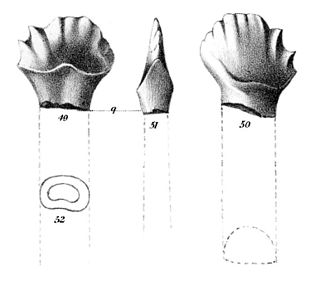Related Research Articles

In physics, the kinetic energy of an object is the form of energy that it possesses due to its motion.
Power is the amount of energy transferred or converted per unit time. In the International System of Units, the unit of power is the watt, equal to one joule per second. Power is a scalar quantity.

In physics, the special theory of relativity, or special relativity for short, is a scientific theory of the relationship between space and time. In Albert Einstein's 1905 paper, On the Electrodynamics of Moving Bodies, the theory is presented as being based on just two postulates:
- The laws of physics are invariant (identical) in all inertial frames of reference. This is known as the principle of relativity.
- The speed of light in vacuum is the same for all observers, regardless of the motion of light source or observer. This is known as the principle of light constancy, or the principle of light speed invariance.

In mathematics, a tensor is an algebraic object that describes a multilinear relationship between sets of algebraic objects related to a vector space. Tensors may map between different objects such as vectors, scalars, and even other tensors. There are many types of tensors, including scalars and vectors, dual vectors, multilinear maps between vector spaces, and even some operations such as the dot product. Tensors are defined independent of any basis, although they are often referred to by their components in a basis related to a particular coordinate system; those components form an array, which can be thought of as a high-dimensional matrix.

In physics and mechanics, torque is the rotational analogue of linear force. It is also referred to as the moment of force. The symbol for torque is typically , the lowercase Greek letter tau. When being referred to as moment of force, it is commonly denoted by M. Just as a linear force is a push or a pull applied to a body, a torque can be thought of as a twist applied to an object with respect to a chosen point; for example, driving a screw uses torque to force it into an object, which is applied by the screwdriver rotating around its axis to the drives on the head.
The Schrödinger equation is a partial differential equation that governs the wave function of a non-relativistic quantum-mechanical system. Its discovery was a significant landmark in the development of quantum mechanics. It is named after Erwin Schrödinger, an Austrian physicist, who postulated the equation in 1925 and published it in 1926, forming the basis for the work that resulted in his Nobel Prize in Physics in 1933.

In biochemistry, Michaelis–Menten kinetics, named after Leonor Michaelis and Maud Menten, is the simplest case of enzyme kinetics, applied to enzyme-catalysed reactions of one substrate and one product. It takes the form of a differential equation describing the reaction rate to , the concentration of the substrate A. Its formula is given by the Michaelis–Menten equation:
Time dilation is the difference in elapsed time as measured by two clocks, either because of a relative velocity between them, or a difference in gravitational potential between their locations. When unspecified, "time dilation" usually refers to the effect due to velocity.

Edmontosaurus, with the second species often colloquially and historically known as Anatosaurus or Anatotitan, is a genus of hadrosaurid (duck-billed) dinosaur. It contains two known species: Edmontosaurus regalis and Edmontosaurus annectens. Fossils of E. regalis have been found in rocks of western North America that date from the late Campanian age of the Cretaceous period 73 million years ago, while those of E. annectens were found in the same geographic region from rocks dated to the end of the Maastrichtian age, 66 million years ago. Edmontosaurus was one of the last non-avian dinosaurs to ever exist, and lived alongside dinosaurs like Triceratops, Tyrannosaurus, Ankylosaurus, and Pachycephalosaurus shortly before the Cretaceous–Paleogene extinction event.
In linear algebra, an eigenvector or characteristic vector is a vector that has its direction unchanged by a given linear transformation. More precisely, an eigenvector, , of a linear transformation, , is scaled by a constant factor, , when the linear transformation is applied to it: . The corresponding eigenvalue, characteristic value, or characteristic root is the multiplying factor .

Agathaumas is a dubious genus of a large ceratopsid dinosaur that lived in Wyoming during the Late Cretaceous. The name comes from Ancient Greek: αγαν - 'much' and θαυμα - 'wonder'. It is estimated to have been 15 metres (49 ft) long and weighed 17.5 tonnes, and was seen as the largest land animal known at the time of its discovery.

Thespesius is a dubious genus of hadrosaurid dinosaur from the late Maastrichtian-age Upper Cretaceous Lance Formation of South Dakota.

Palaeoscincus is a dubious genus of ankylosaurian dinosaur based on teeth from the mid-late Campanian-age Upper Cretaceous Judith River Formation of Montana. Like several other dinosaur genera named by Joseph Leidy, it is an historically important genus with a convoluted taxonomy that has been all but abandoned by modern dinosaur paleontologists. Because of its wide use in the early 20th century, it was somewhat well known to the general public, often through illustrations of an animal with the armor of Edmontonia and the tail club of an ankylosaurid.

In electrical engineering, a capacitor is a device that stores electrical energy by accumulating electric charges on two closely spaced surfaces that are insulated from each other. The capacitor was originally known as the condenser, a term still encountered in a few compound names, such as the condenser microphone. It is a passive electronic component with two terminals.

Edmontosaurus regalis is a species of comb-crested hadrosaurid dinosaur. Fossils of E. regalis have been found in rocks of western North America that date from the late Campanian age of the Cretaceous Period 73 million years ago, but it may have possibly lived into the early Maastrichtian.

Edmontosaurus annectens, often colloquially and historically known as Anatosaurus, is a species of flat-headed saurolophine hadrosaurid dinosaur from the late Maastrichtian age at the very end of the Cretaceous period, in what is now western North America. Remains of E. annectens have been preserved in the Frenchman, Hell Creek, and Lance Formations. All of these formations are dated to the late Maastrichtian age of the Late Cretaceous period, which represents the last three million years before the extinction of the non-avian dinosaurs. E. annectens is also found in the Laramie Formation, and magnetostratigraphy suggests an age of 69–68 Ma for the Laramie Formation. Edmontosaurus annectens is known from numerous specimens, including at least twenty partial-to-complete skulls, discovered in the U.S. states of Montana, South Dakota, North Dakota, Wyoming, and Colorado, as well as the Canadian province of Saskatchewan. It had an extremely long and low skull, and was quite a large animal, growing up to approximately 12 metres (39 ft) in length and 5.6 metric tons in average asymptotic body mass, although it could have been even larger. E. annectens exhibits one of the most striking examples of the "duckbill" snout that is common to hadrosaurs. It has a long taxonomic history, and specimens have at times been classified as Diclonius, Trachodon, Hadrosaurus, Claosaurus, Thespesius, Anatosaurus, and Anatotitan before all being grouped together in Edmontosaurus.

Classical mechanics is a physical theory describing the motion of objects such as projectiles, parts of machinery, spacecraft, planets, stars, and galaxies. The development of classical mechanics involved substantial change in the methods and philosophy of physics. The qualifier classical distinguishes this type of mechanics from physics developed after the revolutions in physics of the early 20th century, all of which revealed limitations in classical mechanics.
T. occidentalis may refer to several different species. The specific epithet occidentalis means 'western.'
Ischyrotherium is an extinct genus named by Joseph Leidy in 1856 for fossils from the lignite deposits in Nebraska. Originally considered an herbivorous cetacean, Leidy then reassigned it to Sirenia as a relative of manatees, before Edward Drinker Cope reclassified it as a non-mammalian, suggesting the new name Ischyrosaurus to better identify its reptilian origins, as he considered it a sauropterygian. Ischyrotherium was found alongside material from the hadrosaur Thespesius and turtles Compsemys and Emys, and the fish Mylognathus. The name Ischyrosaurus was also used by John Whitaker Hulke for the sauropod now known as Ornithopsis manseli, as he was unaware it was preoccupied by Cope.
References
- ↑ St. Thespesius Catholic Online